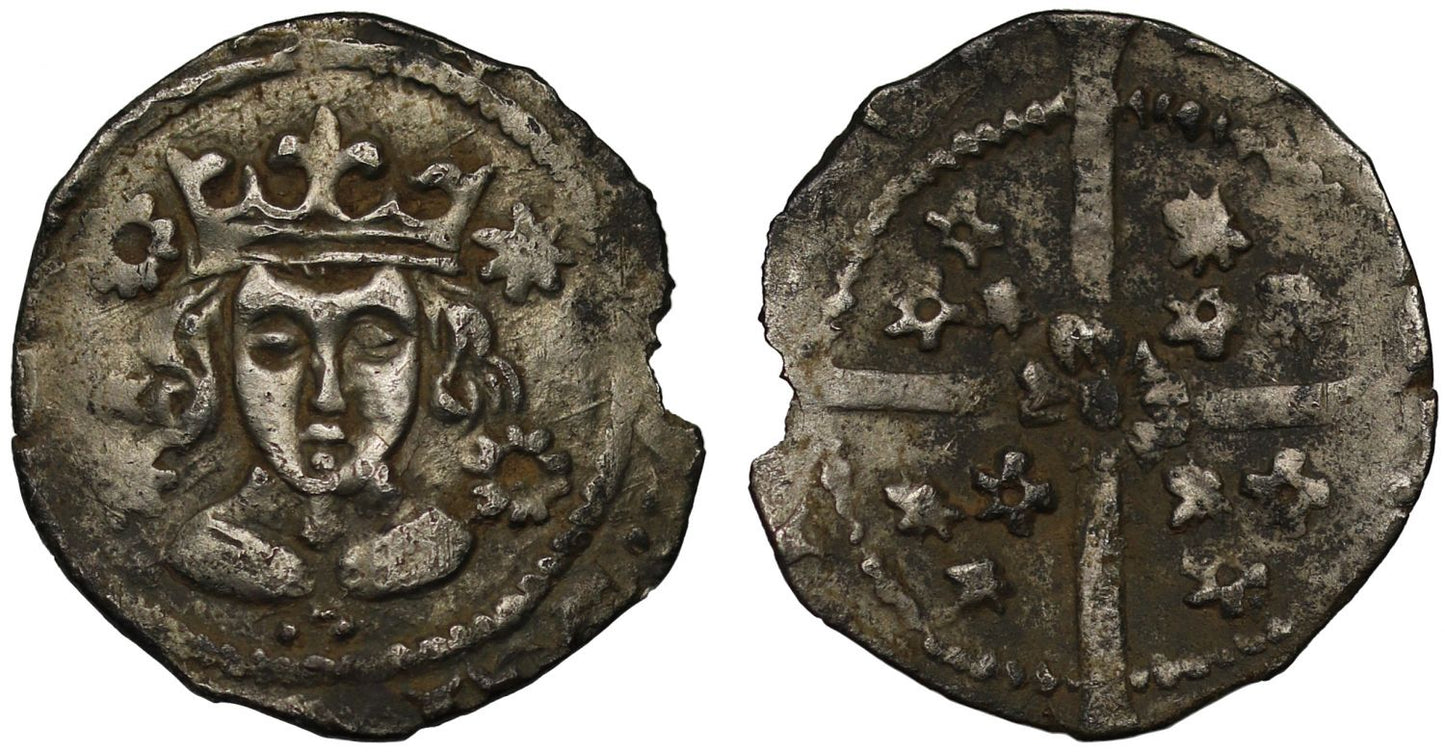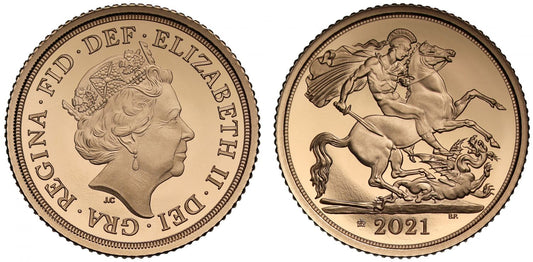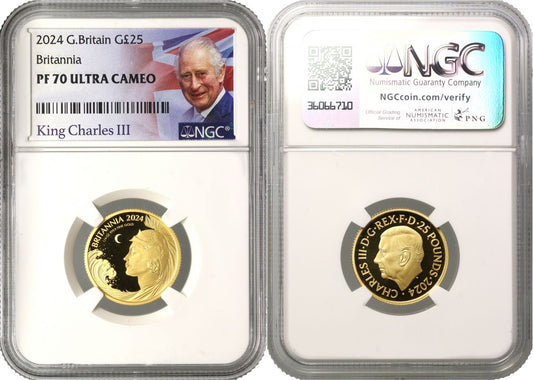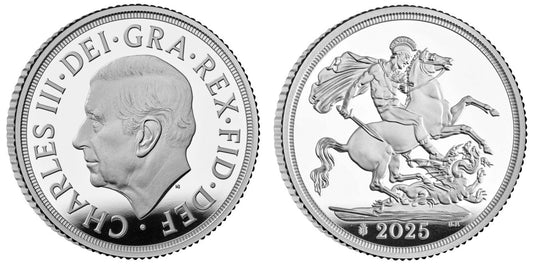FAQs
What makes a coin valuable?
I have coins to sell, what’s the next step?
How will my purchases be shipped?
What happens if I’m not entirely happy with my purchase?
Ireland, Edward IV Penny, Dublin Mint, sun & rose issue Large Symbols
Ireland, Edward IV (1461-83), silver Penny, Dublin Mint, sun and roses issue, Burns group 6 (1479-83), crowned head facing, large sun to right of crown and left of neck, large rose to left of crown and right of neck, bust high with two tiny pellets beneath, inner circle and legend surrounding partially off flan as per usual, rev. rose at centre of long cross, sun and two roses in two opposing angles, rose and two suns in other opposing angles, though all appear sun-like, weight 0.43g (cf.Burns S-4; DF.167; cf.S.6389B). Toned, rim a little chipped, slight bend in flan, otherwise a bold very fine for issue, the higher bust reveals two tiny pellets below not noted in the references for this coinage, very rare.
Born on the 28th April 1442 in Rouen, the son of Richard Plantagenet the third Duke of York, Edward inherited the Yorkist claim on the death of his Father at the Battle of Wakefield in December 1460. After then defeating Lancastrian forces at the Battle of Towton on 29th March 1461 in a snowstorm, he deposed King Henry VI imprisoning him in the Tower of London. Edward went on to marry Elizabeth Woodville on 1st May 1464 with whom he had seven daughters and three sons, seven of which survived him, though the two surviving sons later became known as the tragic "Princes in the Tower".
Firstly, though the marriage of Edward to Elizabeth enraged the Earl of Warwick, as Elizabeth was a widow of Lancastrian John Grey of Groby killed at Towton and had had two sons with him. Later Edward dismissed his Lord Chancellor in 1467 George Neville the Archbishop of York, who was Warwick's brother causing Warwick to form an alliance against Edward with the latter's younger brother the Duke of Clarence, who owned neighbouring estates to Warwick. King Edward then blocked a marriage proposal between Clarence and Warwick's eldest daughter Isabel, but the marriage went ahead and took place in Calais, France presided over by George Neville. The three men then issued a "remonstrance" of alleged abuses by the Woodvilles and other advisors of Edward, returned to London and raised an army which went on to defeat the Royal army at Edgecote Moor on 24th July 1469 with Edward then being held at Middleham Castle. On the 12th August Edward's Father in law Richard Woodville and his youngest son John were executed at Kenilworth Castle, but subsequent support for the actions of Warwick and Neville were low and Edward was released in September to resume rule. Edward went on to reinstate Henry Percy as Earl of Northumberland, who had previously fought for Lancaster giving back his estates that had been presented to John Neville, Warwick's brother with Neville in turn being given the title Marquess of Montague as compensation. By March of 1470 Warwick and Clarence escalated a more private feud into a full scale revolt, but were defeated fleeing to France by May of that year. Louis XI encouraged Warwick to negotiate an alliance with Queen Margaret, and with French support they landed in England on 9th September 1470 to restore King Henry. An army of 30,000 was formed as Yorkist support in England was low. Edward narrowly escaped capture to Bruges and Henry was restored. Edward received little support from his brother in law Charles the Bold, but by March 1471 backed by Flemish merchants he landed near Hull close to his Yorkshire estates, and persuading the City of York to open its gates to him. He marched south gaining more support along the way entering London unchallenged and taking Henry prisoner. Warwick was defeated and killed at the Battle of Barnet on 14th April 1471, and Edward Westminster the son of Henry, was killed at the Battle of Tewkesbury on 4th May 1471, with the imprisoned Henry dying shortly after. Edward's second period of rule began, and he had only to quell one significant rebellion in February 1474 by John de Vere the 13th Earl of Oxford, who survived to be in command of the Lancastrian army at Bosworth field nine years later. The Duke of Clarence was alleged to have been involved in the rebellion leading to his execution at the Tower on 18th February 1478. In 1475 Edward allied with Burgundy to declare war on France and Louis opened negotiations with Edward, landing at Calais and signing the Treaty of Picquigny giving a payment of 75,000 crowns to Edward and a pension of 50,000 more a year which helped recoup costs of his army. In 1482 Edward backed an attempt by Alexander Stewart to usurp the Scottish throne from James III which led to withdrawal, only capturing Berwick Castle. Edward fell fatally ill at Easter 1483 and survived long enough to add codicils to his will placing his brother Richard as Protector of his son Edward. Edward IV died on the 9th April 1483.
The Hiberno Norse settlement of Dublin was founded by the Vikings on the banks of the River Liffey around 841 with the name literally meaning "the Black Pool" and was an early fortification with ditch, earth rampart and palisade. Stone walls were later constructed in the 11th Century and a man made hill on which to have important political meetings. The Danes slowly converted to Christianity and the first Bishop of Dublin was appointed in 1028 and Christchurch Cathedral began construction. The town was sacked several times over the years in battles between the Irish and Viking Danes but the settlement grew to be the biggest and most important in Ireland and trade links were strong with Chester and Bristol. The wooden Norman style fort was replaced by a stone castle in the early 13th Century and gained its first mayor in 1229. The four so-called "obedient shires" at this time were the Eastern counties of Meath, Louth, Kildare and Dublin and a boundary line known as the pale, marked the land as the King's perimeter and the people within received a degree of protection from the crown; whereas those beyond it were subject to more savage laws of the Irish and perhaps harsher living standards, through time evolving the colloquial phrase "beyond the pale". Dublin continues as a strong capital city to this day.
Provenance:
Ex Dix Noonan Webb, Auction 172, 11th March 2020, lot 199..
Ex Collection of an English Doctor part III, Sovereign Rarities fixed price list online September 2022.
FAQs
What makes a coin valuable?
I have coins to sell, what’s the next step?
How will my purchases be shipped?
What happens if I’m not entirely happy with my purchase?













